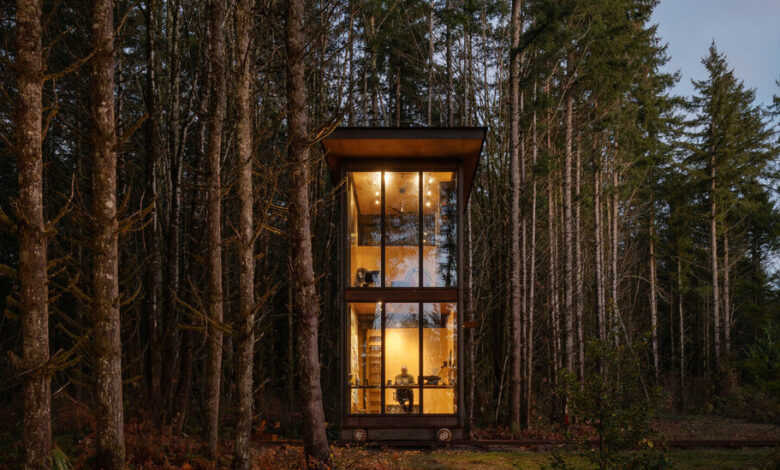Studio Railroad: This Home Office in Washington Is Also a Train

When it’s time for Lou Maxon to commute to work, he never has to worry about missing his train. Why? His office is the train.
When Mr. Maxon steps inside and pulls a lever, the entire two-story structure pulls away from his house in Carnation, Wash., and rolls down a 110-foot-long track — his own personal railroad.
“There’s a detachment to literally leaving the house,” said Mr. Maxon, 48, a creative director who has worked in branding and marketing for clients including Lexus, Microsoft and Lego, and who previously had a connected home office where he struggled with distractions.
Beyond the peace and quiet, the mobility of the building allows him to take in inspiring views. “There are different moments along the rail,” he said. “If you take it halfway, that’s where our fire pit is. If you take it all the way out, you move from being open to being really in the woods, where the light is just different.”
Built from weathering steel and glass, with a metal door finished in bright yellow automotive paint, the studio measures just under 300 square feet. It was designed by Tom Kundig, the architect who founded the Seattle-based firm Olson Kundig. Known for its buildings with moving parts — from hand-cranked glass walls to camping huts mounted on enormous casters — the firm actually has a staff member with the job title of gizmologist: Phil Turner, who specializes in making some of Mr. Kundig’s more audacious ideas reality.
But even a studio railroad initially seemed like the stuff of dreams. “I just said, offhand, ‘Wouldn’t it be cool if you could just take that office, that studio, and put it on tracks,’” recalled Mr. Kundig, describing the meeting where he listened to Mr. Maxon explain his desire for a home office that could provide isolation. “It was a joke.”
But the more they batted the idea around, the more appealing it seemed — and the more daunting. “It’s a really simple idea, but requires all sorts of craziness to get there,” Mr. Kundig said. “It’s one thing to draw it, but it’s another thing to deliver it.”
In other words, he said, “I didn’t know how to pull something like this off.”
Mr. Maxon first met Mr. Kundig in 2008, shortly after he and his wife, Kim Maxon, 52, bought their 21.5-acre lot outside Seattle for around $328,000, with the idea of building a modernist home they could share with their children, Henry, now 23, Jack, 20, and Charlie, 16. Ms. Maxon gave her husband a book about Mr. Kundig’s work as a Christmas gift and, flipping through its pages, they decided he was the architect for the job.
The process of designing and building the house took longer than they expected because of challenges with the steep site and the intricacies of obtaining a construction loan following the financial crisis. When the house was finally completed in 2016, Mr. Maxon dove head first into the design and construction of his rolling studio.
Naturally curious and keen to prove that the idea could be realized, Mr. Maxon decided he wouldn’t just be the conductor of the finished structure — he would also be the general contractor and personally work through the details, find the necessary materials and parts, and orchestrate the construction.
“Between 2016 and 2018, it was a lot of research,” he said. “I approached the studio like I would any project.” He read about railroads that used to run through the area, befriended workers at a nearby rail yard and spent vacations riding the rails.
“I went crazy for trains,” he said. “I found myself, on a Sunday afternoon, at a train show. We took the Empire Builder, which was the original Great Northern, from Seattle to Chicago and back. I went on a trip to Japan with my son, and we went on trains.”
To build his own railroad, Mr. Maxon sourced reclaimed rails from Harmer Steel that were once used by the Great Northern Railway. To ensure that the rails remained flat and straight, excavators dug deep into the earth along the desired route and filled the void with 27 dump-truck loads of stone track ballast.
To construct the studio building, Mr. Maxon worked with Alpine Welding and Equipment, a frequent Olson Kundig collaborator.
Such an unconventional project was “tantalizing to people like us,” said Tim Odell, the owner of the company, who not only did the steelwork but also helped Mr. Maxon assemble the systems that would make the studio move, working with his employee Jesse Thomson. “When you start talking about a project where we can do something that’s kinetic, we get really excited.”
Alpine prefabricated most of the structure in sections before craning and connecting the pieces on the rails. Inside, the studio is finished in more steel, plywood and exposed electrical conduit. The first floor has a desk and serves as Mr. Maxon’s primary work space. The second floor, reached by a ladder, is his library.
The 35,000-pound structure sits on custom-made wheels emblazoned with Mr. Maxon’s professional logo and is powered by an electric engine connected to a retracting wire hidden behind one of the rails. For the controls, Mr. Maxon found a vintage General Motors Electro-Motive Division control panel from South Korea on eBay, after one of his rail yard friends told him what to look for.
One of the levers on the control panel sets the direction and another adjusts the throttle, but there was one lever left over, Mr. Maxon said: “We didn’t need the dynamic brake function.”
Soon, however, he realized that it would be difficult to climb up to his library while carrying books or a laptop. So Mr. Odell and Mr. Thomson devised a dumbwaiter powered by a small conveyer-belt motor, which they installed beside the ladder and wired to that extra lever.
The rolling building was completed in November 2022, at a total cost of about $375,000, including the structure and the railroad.
The first time Ms. Maxon saw the studio move, she could barely believe her eyes. “I’m not the visionary in the family — that’s Lou. So I was a little apprehensive before it got built, because I couldn’t picture it,” she said. “But the first time they ran it down the tracks, I was just flabbergasted and in awe.”
Although Mr. Maxon has finished building his personal railroad, his new passion seems to have stuck. This summer, he said, “we fly to London to see our son, but then we’re taking the train up to Edinburgh.” Next year, he and Ms. Maxon are planning a similar train trip in Japan. Professionally, he has also started working on a few railway museum projects.
“I’m just part of the railroad community now,” he said, noting that he has filled his studio with related memorabilia, including a model train, a vintage first-aid kit and a Great Northern Railway sign. “In addition to being a studio, it’s a bit of a mini moving monument to the railroads.”
Living Small is a biweekly column exploring what it takes to lead a simpler, more sustainable or more compact life.
For weekly email updates on residential real estate news, sign up here.
Source link






